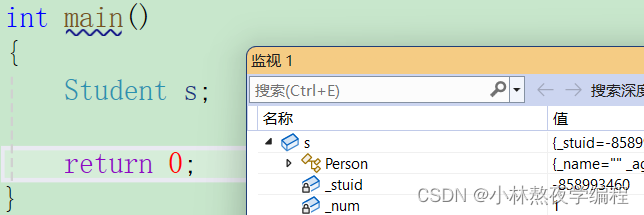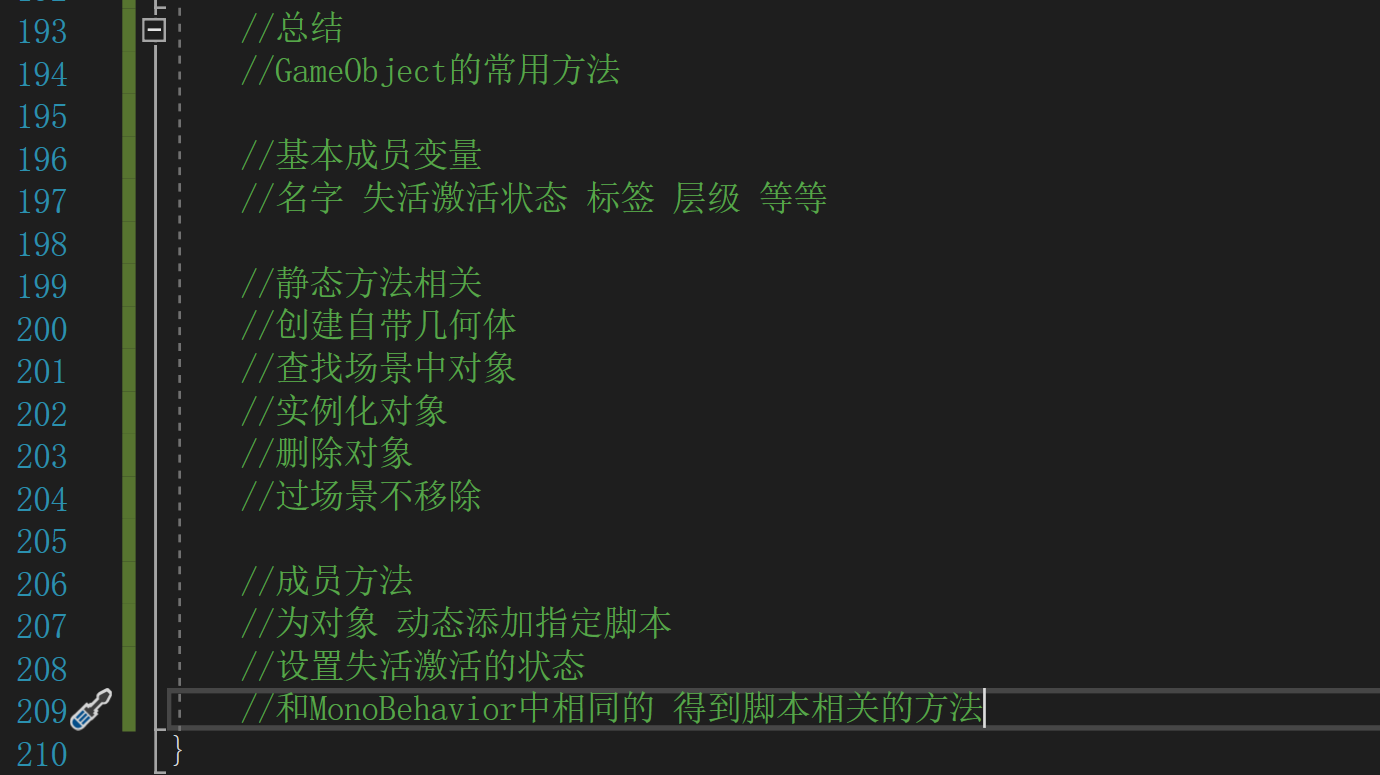一、二分查找
二分查找算法也称折半查找,是一种非常高效的工作于有序数组的查找算法。
时间复杂度
- 最坏情况:O(log n)
- 最好情况:如果待查找元素恰好在数组中央,只需要循环一次O(1)
空间复杂度
- 递归->O(log n);迭代->O(1)
1. 基础版
需求:在有序数组a内,查找值target
- 如果找到返回索引
- 如果找不到返回-1
算法描述
| 前提 | 给定一个包含n个元素的有序数组A,满足A{0}≤A{1}≤A{2}≤...≤A{n-1},一个待查值target |
| 1 | 设置i=0, j=n-1 |
| 2 | 如果i>j,结束查找,没找到 |
| 3 | 设置m=floor((i+j)/2),m为中间索引,floor是向下取整 |
| 4 | 如果target<A{m},设置j=m-1,跳到第2步 |
| 5 | 如果target>A{m},设置i=m+1,跳到第2步 |
| 6 | 如果A{m}=target,结束查找,找到了 |
Java实现:
public static int binarySearch(int[] a, int target) {
int i = 0, j = a.length - 1;
while (i <= j) {
int m = (i + j) >>> 1;
if (target < a[m]) { // 在左边
j = m - 1;
} else if (a[m] < target) { // 在右边
i = m + 1;
} else {
return m;
}
}
return -1;
}-
i,j 对应着搜索区间 [0,a.length-1](注意是闭合的区间),i<=j 意味着搜索区间内还有未比较的元素,i, j 指向的元素也可能是比较的目标
-
思考:如果不加 i==j 行不行?
-
回答:不行,因为这意味着 i,j 指向的元素会漏过比较
-
-
m 对应着中间位置,中间位置左边和右边的元素可能不相等(差一个),不会影响结果
-
如果某次未找到,那么缩小后的区间内不包含 m
2. 改变版
public static int binarySearch(int[] a, int target) {
int i = 0, j = a.length;
while (i < j) {
int m = (i + j) >>> 1;
if (target < a[m]) { // 在左边
j = m;
} else if (a[m] < target) { // 在右边
i = m + 1;
} else {
return m;
}
}
return -1;
}-
i,j 对应着搜索区间 [0,a.length)(注意是左闭右开的区间),i<j 意味着搜索区间内还有未比较的元素,j 指向的一定不是查找目标
-
思考:为啥这次不加 i==j 的条件了?
-
回答:这回 j 指向的不是查找目标,如果还加 i==j 条件,就意味着 j 指向的还会再次比较,找不到时,会死循环
-
-
如果某次要缩小右边界,那么 j=m,因为此时的 m 已经不是查找目标了
3. 平衡版
public static int binarySearchBalance(int[] a, int target) {
int i = 0, j = a.length;
while (1 < j - i) {
int m = (i + j) >>> 1;
if (target < a[m]) {
j = m;
} else {
i = m;
}
}
return (a[i] == target) ? i : -1;
}思想:
-
左闭右开的区间,i 指向的可能是目标,而 j 指向的不是目标
-
不奢望循环内通过 m 找出目标, 缩小区间直至剩 1 个, 剩下的这个可能就是要找的(通过 i)
-
j - i > 1 的含义是,在范围内待比较的元素个数 > 1
-
-
改变 i 边界时,它指向的可能是目标,因此不能 m+1
-
循环内的平均比较次数减少了
-
时间复杂度 Θ(log(n))
4. Java版 - 基础版
private static int binarySearch0(long[] a, int fromIndex, int toIndex,
long key) {
int low = fromIndex;
int high = toIndex - 1;
while (low <= high) {
int mid = (low + high) >>> 1;
long midVal = a[mid];
if (midVal < key)
low = mid + 1;
else if (midVal > key)
high = mid - 1;
else
return mid; // key found
}
return -(low + 1); // key not found.
}-
例如 [1,3,5,6] 要插入 2 那么就是找到一个位置,这个位置左侧元素都比它小
-
等循环结束,若没找到,low 左侧元素肯定都比 target 小,因此 low 即插入点
-
-
插入点取负是为了与找到情况区分
-
-1 是为了把索引 0 位置的插入点与找到的情况进行区分
5. Leftmost
有时我们希望返回的是最左侧的重复元素,如果采用Basic二分查找
-
对于数组 [1, 2, 3, 4, 4, 5, 6, 7],查找元素4,结果是索引3
-
对于数组 [1, 2, 4, 4, 4, 5, 6, 7],查找元素4,结果也是索引3,并不是最左侧的元素
public static int binarySearchLeftmost1(int[] a, int target) {
int i = 0, j = a.length - 1;
int candidate = -1;
while (i <= j) {
int m = (i + j) >>> 1;
if (target < a[m]) {
j = m - 1;
} else if (a[m] < target) {
i = m + 1;
} else {
candidate = m; // 记录候选位置
j = m - 1; // 继续向左
}
}
return candidate;
}6. Rightmost
如果希望返回的是最右侧元素
public static int binarySearchRightmost1(int[] a, int target) {
int i = 0, j = a.length - 1;
int candidate = -1;
while (i <= j) {
int m = (i + j) >>> 1;
if (target < a[m]) {
j = m - 1;
} else if (a[m] < target) {
i = m + 1;
} else {
candidate = m; // 记录候选位置
i = m + 1; // 继续向右
}
}
return candidate;
}7. 应用
对于Leftmost与Rightmost,可以返回一个比-1更有用的值
Leftmost改为
public static int binarySearchLeftmost(int[] a, int target) {
int i = 0, j = a.length - 1;
while (i <= j) {
int m = (i + j) >>> 1;
if (target <= a[m]) {
j = m - 1;
} else {
i = m + 1;
}
}
return i;
}- Leftmost返回值的另一层含义:小于target的元素个数,≥target的最靠左索引
- 小于等于中间值,都要向左找
Rightmost改为
public static int binarySearchRightmost(int[] a, int target) {
int i = 0, j = a.length - 1;
while (i <= j) {
int m = (i + j) >>> 1;
if (target < a[m]) {
j = m - 1;
} else {
i = m + 1;
}
}
return i - 1;
}- Rightmost返回值的另一层含义:≤target的最靠左索引
- 大于等于中间值,都要向右找
8. 几个名词

范围查询
- 查询x<4,0...leftmost(4) - 1
- 查询x ≤ 4,0...rightmost(4)
- 查询4 < x,rightmost(4) + 1 ... infty
- 查询4 ≤ x,leftmost(4) ... infty
- 查询4 ≤ x ≤ 7,leftmost(4) ... rightmost(7)
- 查询4 < x < 7,rightmost(4) + 1 ... leftmost(7) - 1
求排名:leftmost(target) + 1
- target可以不存在,如:leftmost(5) + 1 = 6
- target也可以存在,如:leftmost(4) + 1 = 3
求前任:leftmost(target) - 1
- leftmost(3) - 1 = 1,前任a[1] = 2
- leftmost(4) - 1 = 1,前任a[1] = 2
求后任:rightmost(target) + 1
- rightmost(5) + 1 = 5,后任a[5] = 7
- rightmost(4) + 1 = 5,后任a[5] = 7
求最近邻居
- 前任和后任距离更近者
9. 习题
9.1 二分查找
给定一个 n 个元素有序的(升序)整型数组 nums 和一个目标值 target ,写一个函数搜索 nums 中的 target,如果目标值存在返回下标,否则返回 -1。
示例 1:
输入: nums = [-1,0,3,5,9,12], target = 9 输出: 4 解释: 9 出现在 nums 中并且下标为 4
示例 2:
输入: nums = [-1,0,3,5,9,12], target = 2
输出: -1
解释: 2 不存在 nums 中因此返回 -1
提示:
- 你可以假设
nums中的所有元素是不重复的。 n将在[1, 10000]之间。nums的每个元素都将在[-9999, 9999]之间。
class Solution {
public int search(int[] nums, int target) {
int i = 0, j = nums.length;
while(i < j) {
int m = (i + j) >>> 1;
if(nums[m] < target) {
i = m + 1;
} else if(target < nums[m]) {
j = m;
} else {
return m;
}
}
return -1;
}
}9.2 搜索插入位置
给定一个排序数组和一个目标值,在数组中找到目标值,并返回其索引。如果目标值不存在于数组中,返回它将会被按顺序插入的位置。
请必须使用时间复杂度为 O(log n) 的算法。
示例 1:
输入: nums = [1,3,5,6], target = 5 输出: 2
示例 2:
输入: nums = [1,3,5,6], target = 2 输出: 1
示例 3:
输入: nums = [1,3,5,6], target = 7 输出: 4
提示:
1 <= nums.length <= 10^4-10^4 <= nums[i] <= 10^4nums为 无重复元素 的 升序 排列数组-10^4 <= target <= 10^4
解法一:用二分查找基础版代码改写,基础版中,找到返回m,没找到i代表插入点
class Solution {
public int searchInsert(int[] nums, int target) {
int i = 0, j = nums.length;
while(i < j) {
int m = (i + j) >>> 1;
if(target < nums[m]) {
j = m;
} else if(nums[m] < target) {
i = m + 1;
} else {
return m;
}
}
return i;
}
}解法二:用二分查找法平衡板改写,平衡版中
-
如果 target == a[i] 返回 i 表示找到
-
如果 target < a[i],例如 target = 2,a[i] = 3,这时就应该在 i 位置插入 2
-
如果 a[i] < target,例如 a[i] = 3,target = 4,这时就应该在 i+1 位置插入 4
class Solution {
public int searchInsert(int[] nums, int target) {
int i = 0, j = nums.length;
while(1 < j - i) {
int m = (i + j) >>> 1;
if(target < nums[m]) {
j = m;
} else {
i = m;
}
}
return (target <= nums[i]) ? i : i + 1;
}
}解法三:用leftmost版本解,返回值即为插入位置(并能处理元素重复的情况)
class Solution {
public int searchInsert(int[] nums, int target) {
int i = 0, j = nums.length;
while(i < j) {
int m = (i + j) >>> 1;
if(target <= nums[m]) {
j = m;
} else {
i = m + 1;
}
}
return i;
}
}9.3 在排序数组中查找元素的第一个位置和最后一个位置
给你一个按照非递减顺序排列的整数数组 nums,和一个目标值 target。请你找出给定目标值在数组中的开始位置和结束位置。
如果数组中不存在目标值 target,返回 [-1, -1]。
你必须设计并实现时间复杂度为 O(log n) 的算法解决此问题。
示例 1:
输入:nums = [5,7,7,8,8,10], target = 8 输出:[3,4]
示例 2:
输入:nums = [5,7,7,8,8,10], target = 6 输出:[-1,-1]
示例 3:
输入:nums = [], target = 0 输出:[-1,-1]
提示:
0 <= nums.length <= 10^5-10^9 <= nums[i] <= 10^9nums是一个非递减数组-10^9 <= target <= 10^9
class Solution {
public static int left(int[] a, int target) {
int i = 0, j = a.length;
int candidate = -1;
while(i < j) {
int m = (i + j) >>> 1;
if(target < a[m]) {
j = m;
} else if(a[m] < target) {
i = m + 1;
} else {
candidate = m;
j = m;
}
}
return candidate;
}
public static int right(int[] a, int target) {
int i = 0, j = a.length;
int candidate = -1;
while(i < j) {
int m = (i + j) >>> 1;
if(target < a[m]) {
j = m;
} else if(a[m] < target) {
i = m + 1;
} else {
candidate = m;
i = m + 1;
}
}
return candidate;
}
public int[] searchRange(int[] nums, int target) {
int x = left(nums, target);
if(x == -1) {
return new int[] {-1, -1};
} else {
return new int[] {x, right(nums, target)};
}
}
}



![[数据集][目标检测]易拉罐底部缺陷检测数据集VOC+YOLO格式1122张5类别](https://i-blog.csdnimg.cn/direct/ad0b156a52584e3296c2417c7a86ff40.png)














